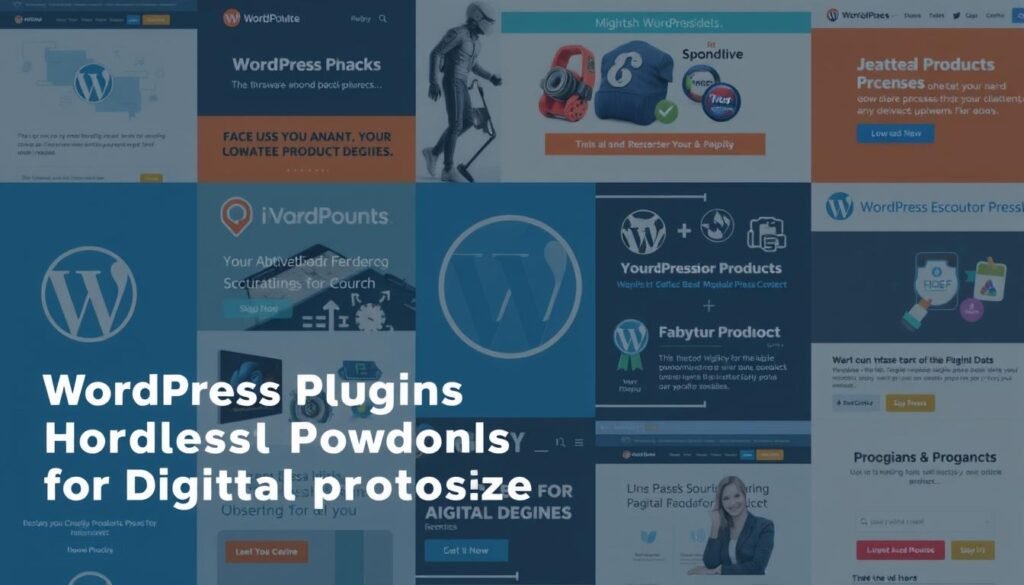Unlocking the Potential of Digital Products: A Beginner’s Journey
Imagine turning your skills and passions into a stream of income that can be accessed from anywhere, at any time. Creating digital products can make this a reality, offering a world of opportunities for those looking to make money online.
With the rise of digital platforms, it’s never been easier to get started with selling digital products. You can create and sell products that cater to various niches, from simple templates to comprehensive online courses. The best part? You don’t need to be tech-savvy to succeed. Exploring beginner-friendly side hustles can provide valuable insights into the world of digital products.
Key Takeaways
- Discover the benefits of creating and selling digital products as a beginner.
- Learn how to identify the right digital products that match your skills and interests.
- Understand the importance of digital platforms in simplifying the creation and sales process.
- Get insights into overcoming technical barriers and outsourcing tasks.
- Find out how to launch your digital product business without getting overwhelmed.
The Lucrative World of Digital Products
In the digital age, creating and selling digital products has emerged as a lucrative business model, ideal for beginners and seasoned entrepreneurs alike. The digital landscape offers a plethora of opportunities for individuals to monetize their skills and knowledge.
What Are Digital Products?
Digital products are intangible goods that can be sold and distributed online. They include e-books, templates, online courses, digital art, and audio products. These products are created once and can be sold multiple times without incurring additional production costs.
Why Digital Products Are Perfect for Beginners
Digital products are perfect for beginners because they require little to no initial investment. You can create digital products based on your existing knowledge and skills, making it easier to get started. Moreover, the digital marketplace is vast, allowing you to reach a global audience.
The Financial Benefits of Selling Digital vs. Physical Products
Selling digital products offers several financial benefits over physical products. Digital products typically offer profit margins of 70-100%, significantly higher than the 10-50% seen with physical products. You can save on inventory storage, packaging materials, and shipping expenses. Additionally, digital products can be sold globally without international shipping concerns, and the automated delivery process enables truly passive income potential.
By leveraging digital products, you can enjoy higher profit margins, reduced overhead costs, and the ability to scale your business without proportional increases in expenses. This makes selling digital products an attractive option for those looking to make money online.
5 Easiest Digital Products to Create for Beginners
You don’t need to be tech-savvy to create digital products; several easy options are available. As a beginner, you can start with simple yet profitable digital products that require minimal technical knowledge.
eBooks and Guides
Creating eBooks and guides is a straightforward process. You can write about your area of expertise and format it into a downloadable PDF. Use your existing knowledge to create valuable content for your audience.
Templates and Printables
Digital templates and printables are in high demand. You can create planners, calendars, or business templates using design tools like Canva. Sell these templates on your website or through marketplaces.

Online Courses and Tutorials
If you have expertise in a particular area, you can create online courses. Platforms like Teachable and Udemy make it easy to host and sell your courses. Focus on providing valuable content that solves a problem for your learners.

Digital Art and Photography
If you have artistic skills, you can create digital art or sell your photographs. Stock photo websites like Shutterstock and Adobe Stock are great platforms to sell your work.
Audio Products and Podcasts
Audio products, such as music tracks, sound effects, guided meditations, and podcast episodes, are popular digital products. You can create these using basic recording equipment and editing software like Audacity. Sell your audio products directly or through platforms like Bandcamp or Audible.
Some popular types of audio products include music tracks, sound effects, guided meditations, affirmations, and premium podcast content. Voice-based products have gained popularity as they can be consumed during commutes or workouts.
How to Create & Sell Digital Products (Even If You’re Not Tech-Savvy)
Turning your expertise into digital products is easier than you think, even without technical skills. The key is to focus on your strengths and simplify the creation process.
Keep Your Digital Products Simple
Creating your digital product doesn’t have to be complicated. You can use tools like course creators available on platforms such as Whop to simplify the process. Alternatively, you can start with Private Label Rights (PLR) products, where you buy an existing course, add your branding, and sell it. The most crucial aspect is having sufficient knowledge on a topic that is in demand.
Focus on One Primary Format
Selecting one primary format for your digital product helps streamline the creation process. Whether it’s an eBook, a template, or an online course, focusing on a single format allows you to deliver high-quality content efficiently. This approach also makes it easier for your customers to consume your product.
Leverage Your Existing Knowledge and Skills
The most valuable digital products come from your unique combination of knowledge, skills, and perspective. Take inventory of your professional experience, hobbies, and challenges you’ve overcome to identify potential product topics. People are willing to pay for information that’s organized in a time-saving, actionable way, especially when it’s backed by your personal experiences and case studies.
To illustrate the potential of leveraging your existing expertise, consider the following table that highlights different digital product ideas based on your skills and knowledge:
| Skill/Knowledge Area | Digital Product Idea | Potential Format |
|---|---|---|
| Marketing expertise | Online marketing course | Video lessons, eBook |
| Graphic design skills | Template bundle | Editable templates |
| Writing experience | eBook or guide | PDF, audiobook |
By focusing on your strengths and simplifying the creation process, you can create digital products that resonate with your audience and save them time. Start by creating products in areas where you already have expertise to minimize research time and maximize your confidence in the content.

Essential Tools for Creating Digital Products
Creating digital products requires the right tools to streamline your process and save time. With the numerous options available, you can find the perfect tools to enhance your productivity and efficiency.
Design Tools for Non-Designers
For those without extensive design experience, there are several user-friendly design tools available. Canva is a popular choice, offering a wide range of templates and a drag-and-drop interface that makes creating professional-looking designs easy.

Content Creation Software
Content creation is a crucial aspect of digital product development. Tools like Grammarly can help you refine your content, ensuring it is error-free and engaging. Additionally, screen recording software like Loom or ScreenFlow can be used to create high-quality video content.

File Management and Organization
Proper file management is crucial for digital product creation. Use cloud storage services like Google Drive, Dropbox, or OneDrive to keep your files organized and accessible from anywhere. Create a consistent folder structure for your products and use clear file naming conventions.
- Establishing a consistent file organization system from the beginning will save countless hours of frustration as your digital product library grows.
- Cloud storage solutions provide automatic backups and access from any device.
- Create separate folders for each product with subfolders for different versions, source files, and final deliverables.
- Use consistent naming conventions that include version numbers and dates (e.g., ProductName_v1.2_04-15-2023) to avoid confusion.
- Schedule regular maintenance time to archive old versions, update file structures, and ensure everything remains organized as your business expands.
Building Your Digital Product Website
Establishing an online presence through a dedicated website is vital for digital product sellers. A well-structured website not only showcases your products but also provides a seamless user experience, encouraging customers to make a purchase.
Choosing the Right Platform
When it comes to selling digital products, selecting the right platform is crucial. You need a platform that supports ecommerce functionalities, particularly for digital downloads. Popular options include Shopify, WooCommerce, and dedicated digital product platforms.
Consider the ease of use, customization options, and integration with payment gateways when choosing a platform. For instance, if you’re using WordPress, WooCommerce is a popular choice due to its seamless integration and extensive features.
Setting Up Your Domain and Hosting
Once you’ve chosen your platform, the next step is to set up your domain and hosting. Your domain name should be memorable and relevant to your brand. For hosting, consider reliable providers that offer good customer support and scalability.
A good hosting service ensures your website remains secure and accessible. Look for providers that offer SSL certificates, as they are essential for securing your site and protecting customer data.
Installing Essential Plugins for Digital Downloads
If you’re using WordPress, installing the right plugins can significantly enhance your website’s functionality. Easy Digital Downloads (EDD) is highly recommended for selling digital products. EDD allows you to create an online store, process payments, and manage file downloads securely.
Other essential plugins include SEO optimization tools like Yoast or Rank Math, caching plugins for improved speed, and security plugins like Wordfence. For email marketing integration, consider plugins that connect your store to services like MailChimp or ConvertKit.
- If using WordPress, Easy Digital Downloads (EDD) is the gold standard plugin for selling digital products, offering secure file delivery and payment processing.
- Other essential plugins include an SEO plugin like Yoast or Rank Math, a caching plugin for speed, and a security plugin like Wordfence.
- For email marketing integration, consider plugins that connect your store to services like MailChimp, ConvertKit, or ActiveCampaign.
- Analytics plugins help track visitor behavior and sales patterns, providing valuable data for optimizing your product offerings.
- Backup plugins are critical for digital product businesses—losing your product files or customer data could be catastrophic.

Pricing Strategies for Digital Products
Your digital product’s price plays a vital role in attracting customers and driving sales. Setting the right price is crucial to balance revenue goals with customer affordability.

Researching Market Rates
To determine the optimal price for your digital product, you need to research the market rates. Analyze what similar products are selling for and understand the pricing trends in your niche. This will give you a baseline to work with and help you identify opportunities to differentiate your product.
By understanding the market rates, you can avoid underpricing or overpricing your digital product. Underpricing can lead to lost revenue, while overpricing can deter potential customers.
Value-Based Pricing Models
Value-based pricing involves setting a price based on the perceived value of your digital product to the customer. This approach focuses on the benefits and results that your product provides, rather than just its features. By emphasizing the value proposition, you can justify higher prices and attract customers who are willing to pay for quality.
Customers are more likely to pay a premium for a digital product that solves a specific problem or meets a particular need. By understanding your target audience’s pain points, you can create a pricing strategy that reflects the value your product provides.
Testing Different Price Points
Testing different price points is essential for finding the optimal price for your digital product. Start with a price based on your market research and then experiment with increases or decreases to see how they affect sales volume and overall revenue. You can also offer limited-time promotions to gauge price sensitivity in your market.
- Price testing helps you understand how customers respond to different price points, allowing you to optimize your pricing strategy.
- Start with a “minimum viable price” that covers your costs and provides some profit, then gradually increase it as you gather testimonials and improve the product.
- A/B testing different price points with identical marketing can reveal price elasticity in your market, sometimes raising prices actually increases sales by elevating perceived value.
Marketing Your Digital Products Without Technical Skills
You don’t need technical skills to market your digital products successfully. With the right strategies, you can reach your target audience and drive sales. Effective marketing involves understanding your audience and using the channels they frequent.
Leveraging Social Media for Promotion
Social media platforms are powerful tools for promoting your digital products. By creating engaging content and using relevant hashtags, you can increase your visibility and attract potential customers. Focus on the platforms where your target audience is most active.
Identify your audience’s preferred social media channels and tailor your content to fit each platform’s unique features. For example, use Instagram for visually appealing products and Twitter for more text-based promotions.
Building an Email List
Building an email list is crucial for directly reaching your customers and promoting your digital products. Use email marketing tools for beginners like Mailchimp or ConvertKit to create sign-up forms and automate your email campaigns. Offering a free resource or discount in exchange for email sign-ups can be an effective strategy.
Creating Content That Drives Sales
Content marketing involves creating valuable, relevant content that attracts your target audience and subtly promotes your digital products. This can include blog posts, videos, podcasts, or social media content. Focus on addressing the pain points and questions your potential customers have.
Effective content builds trust and positions you as an authority in your niche, making it easier to sell your products. Key strategies include:
- The most effective content for selling digital products addresses specific pain points your audience experiences and positions your product as the solution.
- Create “cornerstone content” that demonstrates your expertise and naturally leads readers toward your paid offerings without feeling overly promotional.
- Use the “Problem-Agitate-Solve” framework in your content: identify a problem your audience faces, emphasize why it matters, then present your product as the solution.
- Repurpose your content across multiple formats to reach different audience preferences—turn blog posts into videos, podcasts into social media content, etc.
- Incorporate customer success stories and testimonials into your content to provide social proof and demonstrate real-world results.
By implementing these strategies, you can effectively market your digital products without needing advanced technical skills. Focus on creating valuable content and leveraging the right marketing channels to reach your audience.
Overcoming Technical Challenges
Creating digital products can be a breeze, even for those who aren’t tech-savvy, if you know how to tackle technical challenges. The key is to understand when to take the DIY route and when to seek help.
When to DIY vs. When to Outsource
When creating a digital product, it’s essential to identify tasks that require professional expertise. While you can handle simple tasks yourself, complex tasks like product photography or video editing might need outsourcing.
Outsourcing to freelancers can be cost-effective. You can find affordable talent on platforms like Upwork or Fiverr.
Budget-Friendly Resources for Technical Help
There are many budget-friendly resources available to help you overcome technical challenges. Online tutorials on YouTube, Udemy courses, and forums like Reddit’s r/entrepreneur are invaluable.
You can also leverage AI tools like ChatGPT to explain technical concepts in simple terms or provide step-by-step instructions for specific tasks.
Learning Only What You Need to Know
Most successful digital product creators aren’t technical experts; they’re subject matter experts who learned just enough tech to deliver their knowledge effectively. Focus on learning the minimum viable technical skills needed for your specific product.
Use the “just in time” learning approach—learn specific skills exactly when you need them. Break down technical challenges into smaller, manageable steps that can be tackled individually through targeted tutorials.
Conclusion
With the right mindset, you can turn your knowledge into profitable digital products. Creating and selling digital products doesn’t require advanced technical skills—it requires valuable knowledge packaged in a way that helps your audience solve problems. To create digital products, start with simple formats that match your current abilities and gradually expand as your confidence and technical skills grow.
Remember, perfection is the enemy of progress—a “good enough” product that’s actually launched will outperform a perfect product that never sees the light of day. The digital product market continues to expand, creating opportunities for creators at all technical skill levels to build profitable online businesses. For more information on how to sell digital products on platforms like WordPress, explore available resources to enhance your sales strategy.
By focusing on providing genuine value to your customers, you can make money and grow your business. The best time to start creating digital products is now—begin with what you know, use the tools you’re comfortable with, and improve incrementally over time.
FAQ
What types of digital products are most profitable?
Do I need to have technical skills to sell digital products?
How do I price my digital products?
What are the benefits of selling digital products over physical products?
Can I sell digital products on social media platforms?
How do I protect my digital products from piracy?
What are the best platforms for selling digital products?
How do I market my digital products to potential customers?
editor's pick
latest video
news via inbox
Nulla turp dis cursus. Integer liberos euismod pretium faucibua




